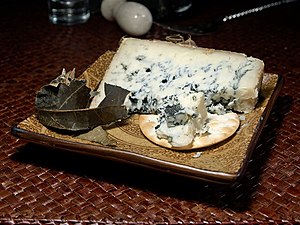Blue cheese: Difference between revisions
Jim-Bronson (talk | contribs) mNo edit summary |
Vivalacheese (talk | contribs) |
||
| Line 97: | Line 97: | ||
==References in popular culture== |
==References in popular culture== |
||
In Fosters Home for Imaginary Friends, Bloo and Cheese are often called 'Bloo Cheese' when seen together. The first episode to show this is 'Mac Daddy'. |
In Fosters Home for Imaginary Friends, Bloo and Cheese are often called 'Bloo Cheese' when seen together. The first episode to show this is 'Mac Daddy'. Also, in Terry Pratchett's Discworld series, the Wee Free Men have to nail the blue cheese to the table because it is so runny. |
||
==External links== |
==External links== |
||
Revision as of 00:00, 6 October 2007

Blue cheese, known in French as bleu ("blue"), is a general classification of cow's milk, sheep's milk, or goat's milk cheeses that has had Penicillium cultures added so that the final product is spotted or veined throughout with blue or blue-green mold. Some blue cheeses are injected with spores before the curds form and others have spores mixed in with the curds after they form. Blue cheeses are typically aged in a temperature-controlled environment such as a cave.
Much like wines, many bleu cheeses such as Roquefort, Gorgonzola, and Stilton are a protected designation of origin in the European Union, meaning they can bear the name only if they have been made in a particular region in a certain country. Similarly, individual countries have protections of their own such as France's Appellation d'Origine Contrôlée and Italy's Denominazione di Origine Protetta.
The characteristic flavor of bleu cheeses tends to be sharp and a bit salty. The smell of this food is pungent, even compared to other cheeses. They can be eaten by themselves or can be crumbled or melted over foods.
Culinary Uses
The unique flavor of bleu cheese is best appreciated alone (at room temperature) or served with fruit, crackers and wine.
Also:
- As a condiment served with Buffalo Wings, although "bleu cheese dressing" may contain no actual cheese.
- Crumbled into salad.
- As a dressing (again, actual cheese content is questionable, but there are several varieties of "chunky" dressing available) served with raw vegetables, specfically carrots, broccoli, cauliflower, etc.
- Crumbled (and/or melted) onto grilled beef steaks, specifically New York and Kansas City Strips.
- On hamburgers, especially covered with cajun seasoning to form the "Black and Bleu" burger.
- Crumbled (and/or melted) onto grilled or roasted lamb.
- It can be used to flavour a risotto or a polenta. Mixed with other famous Italian cheeses it forms the condiment for pasta quattro formaggi.
History
Blue cheese is believed to have been discovered by accident. The caves that early cheeses were aged in shared the properties of being temperature and moisture controlled environments, as well as being favorable to many varieties of mold. Roquefort is said to have been invented in 1070 AD. Gorgonzola is one of the oldest known blue cheeses, having been created around 879 AD, though it is said that it did not actually contain blue-veins until around the 11th century. Stilton is a relatively new addition occurring sometime in the 18th century. Many varieties of blue cheese that originated subsequently were an attempt to fill the demand for Roquefort-style cheeses that were prohibitive either due to cost or politics.
Select types
- Adelost
- Amablu
- Asturian blue La Peral
- Aura
- Australian Blue Vein
- Bavaria blu
- Beenleigh Blue
- Bergader
- Bergere Bleue
- Bleu Bénédictin
- Bleu d'Auvergne
- Bleu de Basque
- Bleu de Bresse
- Bleu de Gex
- Bleu de Laqueuille
- Bleu des Causses
- Bleu de Septmoncel
- Bleu du Haut-Jura
- Bleu du Vercors-Sassenage
- Blue Castello
- Blue Cheshire
- Blue Rathgore
- Blue Wensleydale
| class="col-break " |
- Buttermilk Blue
- Buxton Blue cheese
- Cabrales cheese
- Cambozola
- Cashel Blue cheese
- Cheshire cheese
- Ciel de Charlevoix
- Clemson Blue
- Danablu
- Devon Blue
- Dolcelatte
- Dorset Blue Vinney cheese
- Dunsyre Blue
- Edelpilz
- Exmoor Blue cheese
- Fourme d'Ambert
- Fourme de Haute Loire
- Fourme de Montbrison
- Gammelost
- Gippsland Blue
- Gorgonzola
- Harbourne Blue
- Jubilee Blue
| class="col-break " |
- Lanark Blue
- Lymeswold cheese
- Maytag Blue cheese
- Meredith Blue
- Montagnolo
- Mycella
- Olivet Bleu
- Oxford Blue
- Oxley Traditional Blue
- Picon
- Point Reyes
- Roaring Forties Blue
- Rochebaron
- Roquefort
- Saga cheese
- Shropshire Blue cheese
- Saint Agur Blue
- St. Pete's Select
- Stilton
- Valdeón cheese
- Waimata Farmhouse Blue
- Westminster Blue
- Yorkshire Blue
References in popular culture
In Fosters Home for Imaginary Friends, Bloo and Cheese are often called 'Bloo Cheese' when seen together. The first episode to show this is 'Mac Daddy'. Also, in Terry Pratchett's Discworld series, the Wee Free Men have to nail the blue cheese to the table because it is so runny.
